PRINCETON, NJ -- A mid-October USA Today/Gallup poll finds the Democrats leading the race to control the U.S. House of Representatives. Gallup's generic congressional ballot finds likely voters preferring the Democratic candidate in their district to the Republican by 51% to 45%, regardless of the likely voter model used.
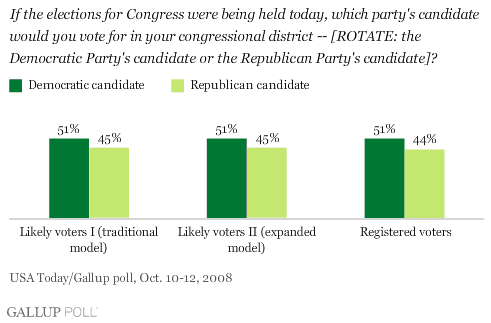
These results represent an improved positioning for the Democratic Party compared to the previous reading on congressional voting intention, taken right after the Republican convention. At that time, Republicans led 50% to 45% among likely voters using Gallup's traditional likely voter model, which assesses likelihood to vote based on current voting intentions and past voting behavior. But that was a temporary boost for the Republicans, and inconsistent with earlier polls that showed Democrats leading.
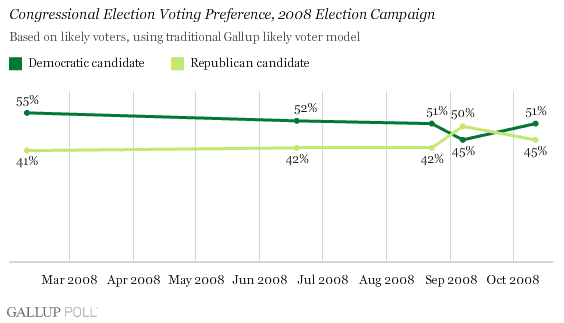
A second, "expanded" likely voter model, which assesses likelihood to vote based only on current voting intentions and would reflect increased turnout by groups that have not voted in past elections, also indicates a stronger showing for the Democrats compared with just after the GOP convention. Using this model, Democrats currently lead 51% to 45% in congressional voting, as opposed to a 48% to 47% Republican advantage in early September. Democrats led in an Aug. 21-23 poll conducted before both parties' conventions took place.
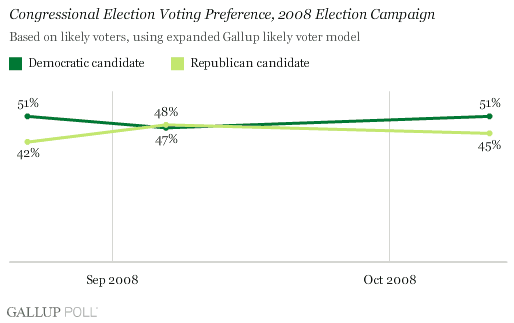
The generic congressional ballot has proven to be an accurate predictor of the overall vote for the House of Representatives historically, and is correlated with the number of seats a party can expect to win. These results indicate that if the election were held today, the Democratic Party would probably retain control of the House. However, it is unclear whether the Democrats would be able to increase their majority much, since the current likely voter results are similar to Gallup's 2006 House vote estimate of 51% to 44% and the actual vote for the House that year, 53% to 45%.
Party loyalty is high in congressional voting, with 95% of Republicans saying they will vote for the Republican candidate in their district and 93% of Democrats intending to vote for the Democrat. Independents help swing the pendulum in the Democrats' direction, preferring the Democratic candidate to the Republican by 49% to 40%.
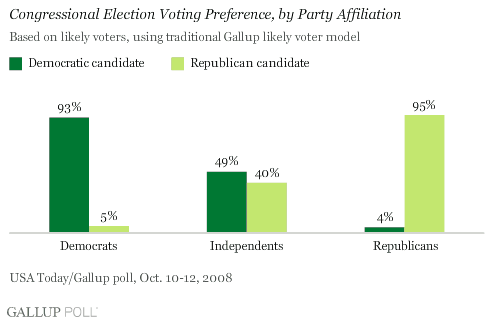
In the post-GOP convention poll, independents were evenly divided in their vote, and Democrats were less likely than Republicans to exhibit party loyalty.
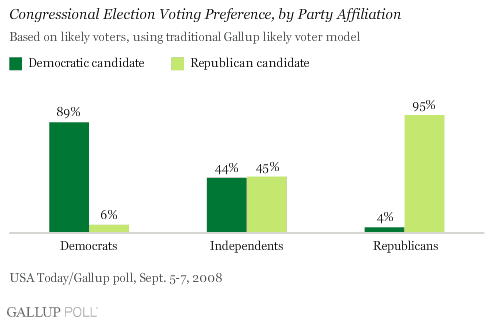
Survey Methods
Results are based on telephone interviews with 1,201 registered voters, aged 18 and older, conducted Oct. 10-12, 2008. For results based on the total sample of registered voters, one can say with 95% confidence that the maximum margin of sampling error is ±3 percentage points.
For results based on the 825 survey respondents deemed most likely to vote according to the traditional Gallup likely voter model (based on past voting behavior and current voting intention), the maximum margin of sampling error is ±4 percentage points.
For results based on the 1,030 survey respondents deemed most likely to vote according to the expanded Gallup likely voter model (based on current voting intention only), the maximum margin of sampling error is ±3 percentage points.
Interviews are conducted with respondents on land-line telephones (for respondents with a land-line telephone) and cellular phones (for respondents who are cell-phone only).
In addition to sampling error, question wording and practical difficulties in conducting surveys can introduce error or bias into the findings of public opinion polls.
